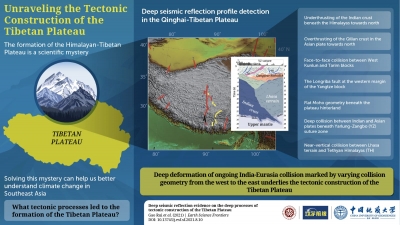BY VISHAL GULATI New Delhi, Nov 28, : .What is it that makes the Himalayan–Tibetan plateau so special? This question has been answered by a team Chinese scientists after decades of research.
They used “deep seismic reflection profiling” to reveal the finer details of continental collision and solve a decades-old mystery.
They believe the results of the study will bring about a’seismic change’ in their understanding of the earth’s crust.
This will allow them to better explore the natural resources and make great strides in the fields of geophysics as well as tectonics.
Scientists have long been fascinated by the Himalayan-Tibetan plateau, a unique geological structure.
Researchers say that although it is well known that the plateau was formed when the Indian continental plate collided with the Eurasian continental plates, researchers have not been able to determine the exact nature of the subterranean architecture.
But that is not the case anymore.
Scientists have finally mapped the structure and deep behaviour of intercontinental collision after decades of research.
The vast Himalayan-Tibetan plateau, which is home to some of the most iconic mountains in the world, is often called the “Roof of the World”.
The plateau towers above the rest of East Asia and South Asia, with an average elevation of 4,500m above sea level.
The idea behind the orogeny or formation of this mountainous area is well understood.
Subduction is a process in which the crust beneath the ocean is absorbed by the earth’s deeper layers.This pulls two continental plates together, making one ‘fold’ over another, leading to the formation of mountains.
One of the most prominent examples of intercontinental collision is the Himalayan-Tibetan Plateau.It is a perfect place to study continental convergence and plate tectonics, according to geophysicists.
Since the 1950s, scientists have conducted seismic tests in the region.
After decades of research, Chinese scholars published a study in Earth Science Frontiers that describes the structure of the crust beneath the Himalayan–Tibetan plateau and the deep behaviours that underlie the ongoing India–Eurasia collision.
“The Himalayan–Tibetan plateau can also be considered a Rosetta Stone for unlocking the mysteries of continent-continent colliding.Professor Gao Rui, Sun Yat-sen University’s first author, said that the area could be considered a natural laboratory to study the phenomenon.
Deep seismic reflection profiling is used to identify the Tibetan plateau’s fine architecture.
This technique involves sending sound waves that are artificially generated into the ground.
They then meet different objects and structures, which bounce back a portion.These sound waves are then recorded on the surface and processed to create a visual representation of the underground structure.
The enormity of the Tibetan plateau, its height and inclement weather conditions have all contributed to the difficulty and scale of this difficult task.
Deep seismic reflection profiling was used by Chinese scholars to study the Tibetan plateau for more than 20 years.
They were able to overcome technical bottlenecks and overcome technical difficulties in order to reach the crust’s lowest layer and the Mohorovicic discontinuity.
The boundary between the crust, the next layer of earth, the mantle, is described by the Moho.
The research team documented the ongoing continental deformation and subduction of the Tibetan plateau in all directions.They also explored the plateau’s hinterland.
Four key points can summarize their discoveries.First, the Indian crust is undergoing northward subduction, while its lower layers are varying their thickness.
Second, the subducting face of the Indian crust is in close contact with the lower crust as well as the mantle suture’ of Eurasian plates.
Third, a crustal scale vertical collision occurred between two regions on the Plateau: the Tethyan Himalayas, and the Lhasa Terrane.
The Eurasian plate is finally subducting in a southwest direction under the Qilian Mountains.This results in a northward advance of the Qilian crust.
Prof.Gao explains that their findings are unique.This question is answered by our study.It also contributes greatly to our understanding of how continental orogenic range-basin system construction works.”
(Vishal Gulati can also be reached at vishal.g@ians.in
vg/dpb #Chinese #examine #deep #behaviours #Tibetan #plateau #Delhi
.







